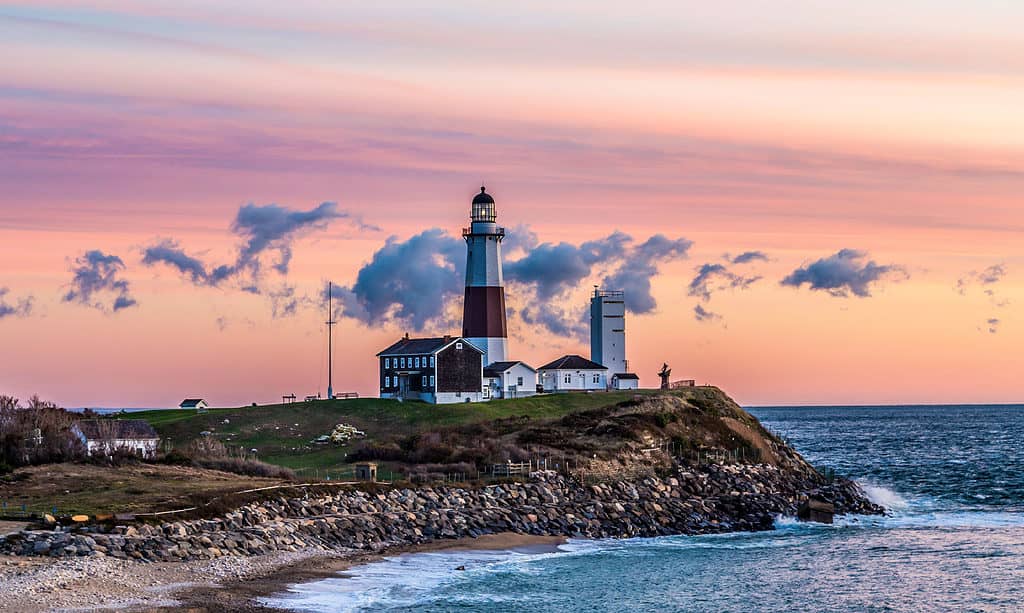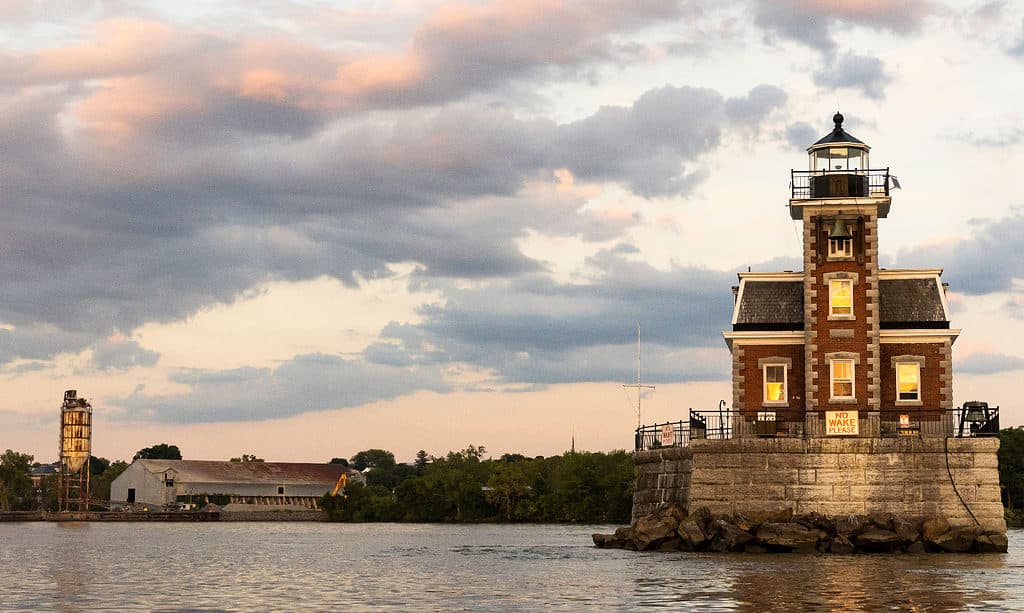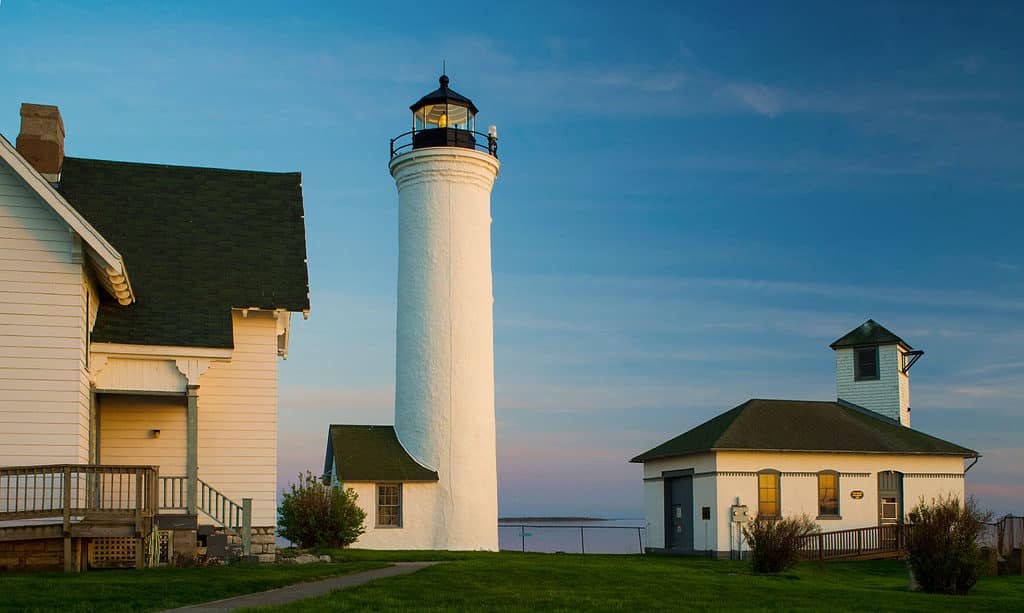The state of New York is famous for many things, from Broadway musicals to the Adirondacks, Catskills, and beyond. One of its oldest attractions is its abundance of beautiful lighthouses. No visit to New York would be complete without visiting some of these historic structures. So, read on to discover which lighthouses you should visit along the way!
1. Montauk Point Lighthouse
The Montauk Point Lighthouse is perhaps the most famous lighthouse in Long Island, New York. It was the first lighthouse to be built in the state of New York. It is currently the fourth oldest lighthouse still in operation today. The Montauk Point Lighthouse stands 110 feet tall on the east side of Long Island, overlooking the Block Island Sound and the Atlantic Ocean. It takes 137 steps to get to the top.
The Montauk Point Lighthouse stands on a site where the British Navy once lit signal fires during the American Revolution, following the traditions of the Montauket tribe. In 1792, President George Washington commissioned its construction. Workers built it from June 7th to November 5th, 1796, with John McComb Jr. at the helm. Using $22,300 from Congress, McComb constructed both the lighthouse and the keepers’ quarters, initially fitting the tower with a first-order Fresnel lens. In 1903, they replaced this with a 3-1/2 order Fresnel lens. By 1987, they had automated the lighthouse, using a 1,000-watt beacon that illuminates 19 miles out to sea.
As World War II loomed in 1939, the United States Coast Guard took over the Montauk Point Lighthouse and erected a second tower beside it, enhancing their submarine surveillance. In 1987, the Montauk Historical Society leased the tower and later purchased the lighthouse in 1996. The Montauk Point Lighthouse earned the title of National Historic Landmark in 2012. Nowadays, people rent it for various events, including music concerts, art exhibitions, weddings, and sporting events like triathlons and relays.

The Montauk Point Lighthouse was built where the British Navy used to light signal fires during the American Revolution.
©iStock.com/Meinzahn
Hudson-Athens Lighthouse
The Hudson-Athens Lighthouse stands atop a mudflat directly between the riverside cities of Huson and Athens.
The Middle Ground Flats in the Hudson River disappear under the rising tide, posing a significant threat to ships sailing by. In the 1830s, locals first suggested building a lighthouse to safeguard their harbors from this danger.
On June 10th, 1872, recognizing the risk, the United States Congress sanctioned $35,000 for the construction of what they termed the Hudson City Lighthouse. Work began in 1873 and by November 1st, 1874, the forty-six-foot tower was ready, with Henry D. Best lighting it up as the first lighthouse keeper.
The lighthouse initially used a sixth-order Fresnel lens, but in 1926, it was swapped for a fifth-order Fresnel lens. Unlike many other lighthouses that came under the jurisdiction of the United States Coast Guard during World War II, the Hudson-Athens Lighthouse had always been under the Coast Guard’s operation. Later, the Hudson-Athens Lighthouse Preservation Society assumed ownership.
Automation Improvements
By the 1950s, the advent of technology allowed for the lighthouse’s complete automation. There was a proposal to dismantle the tower and replace it with a simple pole light. However, thanks to the Hudson River Valley Commission, they repurposed the lighthouse as a recreational park. The structure remained largely untouched until 1982 when residents from neighboring cities formed the Hudson-Athens Lighthouse Preservation Society (HALPS) and took on the responsibility of its upkeep.
Today, visitors can only reach the Hudson-Athens Lighthouse by boat. HALPS offers yearly tours between July and October. The lighthouse continues to guide ships along the Hudson River with its automated light.

The Hudson-Athens Lighthouse was lit by its inaugural lighthouse keeper Henry D. Best.
©iStock.com/JD Urban
Dunkirk Lighthouse
The town of Dunkirk, New York lies along the shoreline of Lake Eerie. It is an important port town with a harbor that could benefit from the presence of a lighthouse.
The Lighthouse in the 19th Century
In May of 1826, the United States Congress approved the construction of the Dunkirk Lighthouse. They provided $6000 to Jesse Peck so he could build the 50-foot tower and lighthouse keeper’s quarters on a twenty-foot cliffside on Point Gratiot. In 1827, Jesse Peck and his team completed the lighthouse. Walter Smith, a merchant and landowner who previously invested in the city’s development after relocating from Fredonia, generously donated the land on which the lighthouse and quarters stand. The lighthouse originally boasted a $10,000 third-order Fresnel lens, installed in 1857, which remains on display to this day.
However, by 1874, the buildings had deteriorated. Over the subsequent two years, a new sixty-one-foot stone tower and a Victorian-style house for the lighthouse keeper emerged, all at a cost of $15,000. The new tower received a sixth-order Fresnel lens and began its operation on July 1st, 1876.
The Lighthouse in the 20th Century
The development of electricity resulted in the dissolution of the lighthouse keeper post in 1923. When World War II began in 1939, the keeper quarters were temporarily occupied by the United States Coast Guard, and soon after slated for demolition. By 1962 the light was automated, and a lease was established between the Coast Guard and a group of citizens to help establish the Dunkirk Lighthouse as a museum and memorial park.
This led to the restoration of the original keepers’ quarters, as well as a gift shop and separate building to display wartime artifacts and objects relevant to the lighthouse’s history. Tours of the lighthouse are available from May to October.

The development of electricity resulted in the dissolution of the lighthouse keeper post in 1923.
©Kenneth Keifer/Shutterstock.com
Tibbetts Point Lighthouse
Captain John Tibbetts donated land to the United States Federal Government in 1827, which became the site for the Tibbetts Point Lighthouse. By October 1st of that year, a thirty-foot tower and a two-story keepers quarters stood proudly on the site, all built for a sum of $1747.
However, within ten years, both the lighthouse and the dwelling showed significant wear and tear. Leaky roofs and other signs of deterioration made it clear that repairs were urgently needed. The deteriorating state drew widespread concern, leading to an official petition to the Lighthouse Board in 1852, seeking restoration.
Recognizing the urgency, the United States Congress allocated $5000 for the renovation. Two years later, on August 1st, 1854, the lighthouse gleamed with a new fourth-order Fresnel lens and was in prime condition. Yet, by 1877, wear and tear again became evident. Renovators completely rebuilt the keeper’s quarters and increased the tower’s height to fifty-nine feet, enhancing Lake Ontario’s navigability. In 1907, the assistant keeper’s dwelling also underwent reconstruction.
Automation Updates
In November 1930, the Tibbetts Point Lighthouse gained electricity. The United States Coast Guard took it over in 1939 as World War II loomed. During the 1970s, they automated the tower’s light. In 1984, the lighthouse keeper’s house transformed into a hostel. The town of Cape Vincent assumed control of the lighthouse in 1991, and with the support of the Tibbets Point Lighthouse Society, they restored the premises.
Now, the Tibbetts Point Lighthouse houses a visitors center and boasts the last functioning Fresnel lens on Lake Ontario. The hostel continues to operate, offering visitors guided tours and a wealth of historical information through exhibits and displays.

Today the Tibbetts Point Lighthouse features a visitors center and the last functioning Fresnel lens on Lake Ontario.
©Larry Knupp/Shutterstock.com
Thirty Mile Point Lighthouse
Unlike some lighthouses, the Thirty Mile Point Lighthouse’s purpose was not to help sailors reach the shore but to mark the coastline as a point of danger for ships to avoid in this part of Lake Ontario. Already the deadly conditions around Thirty Mile Point had doomed four vessels. They were the Le Griffon, a ship commandeered by the famous explorer and fur-trader René-Robert Cavelier, Sieur de La Salle, and the H.M.S. Ontario, a Revolutionary War-era British warship with 88 passengers, all of whom died in the incident.
By 1872 the local Lighthouse Board called for the erection of a lighthouse for the area. They secured $30,000 from United States Congress by March of the following year. Construction was delayed by multiple issues. These included the necessary purchasing of 2 acres of farmland, creating a road and bridge for the workers to use while building the premises, and the persistence of inclement weather.
Completed in January 1875, the seventy-foot stone tower boasts a third-order Fresnel lens with a reach of up to 18 miles over the sea. Additionally, a two-story, seven-room dwelling was constructed on site to accommodate the lighthouse keepers and their assistants. The Thirty Mile Point Lighthouse received electricity in 1885. It remained in the care of successive lighthouse keepers until 1939 when the United States Coast Guard took control of most U.S. lighthouses in the wake of World War II.
Decommissioned
The state of New York purchased the decommissioned lighthouse in 1962. By 1984, it earned a spot on the National Register of Historic Places. Since then, the area transformed into the Golden Hill State Park. The Friends of Thirty Mile Point Lighthouse played a vital role in rebuilding the tower and keepers’ dwellings. Visitors can camp in the park and even rent the third story of the lighthouse for week-long stays. Today, the lighthouse offers guided tours, museum displays, and a gift shop, making it a must-visit spot on Lake Ontario.

©Mary Shelsby/Shutterstock.com
The photo featured at the top of this post is © iStock.com/MikeRega
FAQs (Frequently Asked Questions)
Which lighthouse is a National Historic Landmark?
In 2012 the Montauk Point Lighthouse became a National Historic Landmark, and today it is often rented as an event space for music, art, weddings, and even sporting events such as triathlons and relays.
Why did the Coast Guard take over control of so many lighthouses?
The United States Coast Guard took over control of many of these lighthouses because of World War II.
Thank you for reading! Have some feedback for us? Contact the AZ Animals editorial team.






